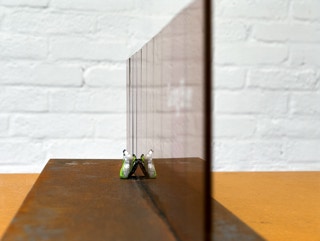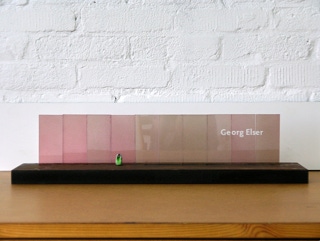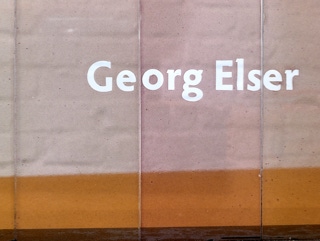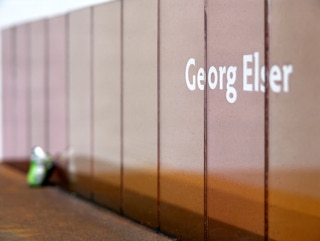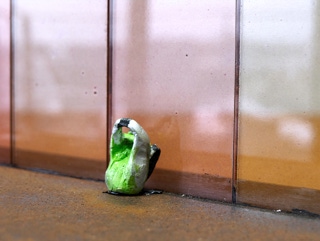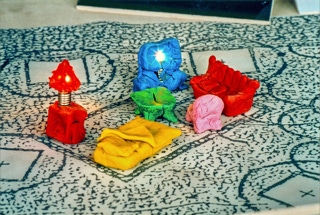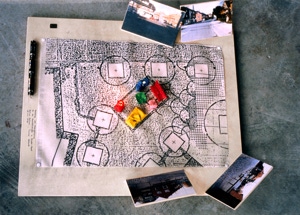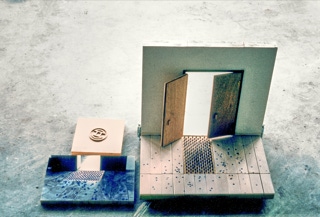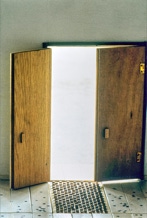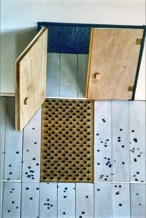Wettbewerbsbeitrag: Denkzeichen für Georg Elser in Berlin, 2010
Das Thema Georg Elser beinhaltet historische und moralische Aspekte. Vor allen Dingen sehe ich in dem Denkmal, neben der historischen Komponente, die Aufgabe eine künstlerisch zeitgemäße Aussage gegen Gewalt zu äußern. Das Denkmal und die Kunst wären wirkungslos, wenn es nur bei der historischen Sicht auf Gewalt stehen bliebe und nicht ebenso der Blick nach vorne gerichtet würde.
Ein Bombenattentat ist prinzipiell ein zu verurteilender radikaler Eingriff in politische Strukturen. Eine künstlerische Verarbeitung eines solchen Themas bedarf einer sensiblen und wohl reflektierten Haltung. Das Denkmal darf weder Gewalt noch Selbstjustiz verherrlichen. Der Tyrannenmord ist in unserer christlich geprägten Gesellschaft ethisch ein äußerst umstrittener Punkt.
Um Georg Elser als Widerstandskämpfer mit einem Denkmal zu würdigen, muss man sein Freiheitsbestreben, seinen Wunsch die Kette der Gewalt zu unterbrechen, seinen Mut zum Handeln und sein politisches Verantwortungsgefühl hervorheben.
Vor diesem Hintergrund schlage ich folgende Skulptur vor.
Ich möchte eine Glaswand mit den Ausmaßen von 2,50Meter Höhe und 12Meter Länge bestehend aus 10einzelnen Scheiben errichten. Sie hat eine bräunlich transparente Färbung und tönt alles, was man dahinter sieht, optisch in Brauntöne. Auf dieser Glaswand steht der Name Georg Elser. Der Schriftzug ist farblos und transparent. Dies ist eine einfache aber inhaltlich und ästhetisch klar gefasste Gedenktafel. Mit ihren Ausmaßen trennt sie einen Teil des Straßenraumes vom „Alltagsfluss“. Korrespondierend zu der bräunlichen Glaswand ist der Boden mit rostigen Cortenstahlblechen gepflastert. Sie formen einen Platz und geben der Skulptur eine konzentrierte Aufmerksamkeit in dieser ansonsten unruhigen Umgebung.
Ein an der Wand abgestellter Rucksack ist die eigentliche Irritation der Skulptur. In unserer heutigen Zeit sind verlassene Gepäckstücke besorgniserregend und beinhalten aktuell immer die Möglichkeit des Attentates. Das Wissen um Georg Elser verstärkt assoziativ die Vermutung, dass es sich um eine Bombe handeln könnte. Hierdurch wird der Betrachter zur Reflexion aufgefordert: ist es ein Fundstück, ist es eine Bombe oder ist es Kunst? Diese beängstigende Situation macht klar, dass Gewalt allgegenwärtig ist und freiheitliche und demokratische Strukturen bedroht bzw. gefährdet.
Der Schriftzug und der Rucksack bilden zwei Punkte, die Fläche der Glasscheiben ästhetisch unterteilen, verbinden und eine bildhafte Komposition aufbauen. Wie zwei Kräftepunkte bekommen sie eine inhaltliche Bedeutung und Wirkung.
Thomas Gerhards
Proposal for a competition: A Monument for Georg Elser in Berlin, 2010
The theme Georg Elser contains historical and moral aspects. First of all, the monument should express a contemporary artistic statement against violence. Both monument and art would be ineffective if it restricted itself to the historical view of violence without looking forward.
In principle, a bomb attack is a condemned radical intervention against political structures. Artistic treatment of such a topic requires a sensitive and well-reflected attitude. The monument should glorify neither violence nor vigilantism. In our society, which is shaped by Christianity, tyrannicide is regarded as ethically extremely controversial.
In order to dedicate a monument to the resistance fighter Georg Elser, one must emphasise his efforts on freedom, his desire to break the chain of violence, his courage to act and his sense of political responsibility.
With this in mind, I propose the following sculpture. I would like to set up a brown glass wall with the dimensions of 2.50metres height x12metres in length consisting of10 individual panes. Seen through this tinted transparent surface, the background appears in shades of brown. The name “Georg Elser“ is written in colourless and transparent letters into the wall. This is a simple but meaningful gesture and an aesthetically precisely designed memorial plaque. The wall separates a part of the street area from the flow of everyday life. Corresponding to the brownish glass wall, the surrounding pavement is covered with rusty corten steel sheets. They define a distinct place and ground the sculpture in this otherwise troubled environment.
A backpack parked on the wall is the real element of irritation of the sculpture. Nowadays, abandoned pieces of luggage are cause for concern and always include the possibility of assassination. In the context of Georg Elser, the backpack increases the presumption that it could be a bomb. In this spirit, the viewer is invited to reflect: Is it a found object, is it a bomb or is it art? This alarming situation makes clear that violence is omnipresent. It threatens or endangers liberal and democratic structures.
The writing and the backpack mark two points, which aesthetically divide the area of the glass panes, connect and create a pictorial composition. Like two points of power they form meaning and effect.
Thomas Gerhards
